
Last modified: 2006-01-14 by antonio martins
Keywords: scimitar | scissors | zulfikar | arm | sword | falchion | checkerboard | swallowtail | error | moor | almoravid | alawit | marinid | star: 8 points (yellow) | octagram |
Links: FOTW homepage |
search |
disclaimer and copyright |
write us |
mirrors
The first inhabitants of Morocco were nomadic
Berber tribes. The
Phoenicians established counters on the
coast around the XIIth century BP and founded Carthage
(now in Tunisia).
The Romans destroyed Carthage in 146 BP, but
the romanisation of Morocco remained very weak. In 429, the
Vandals from Spain invaded Morocco, which was
eventually incorporated to the Byzantine Empire
by Justinian in 534.
Ivan Sache, 15 Jun 2003, based on
[lux01]
In the beginning of the VIIIth century, the Arab chief Musa bin Nosayr
seized Tangiers, established a governor in the city, and introduced
Islam on Morocco. The Berbers were converted to Islam but revolted in
740 and founded independant principalities in the Rif mountains. Princes
Idris I (d. 791) and Idris II (d. 828) ruled all the Berber tribes and
spread Sunni Islam among them. The Idrisids (789-985) founded the city of
Fes, which was their religious, political and economical capital city.
However, the Idrisid power declined after Idris II’s death and Morocco
was disputed between the Fatimids of Ifrikiya (now Tunisia and eastern
Algeria) and the Spanish Umayyads during the Xth century.
Ivan Sache, 15 Jun 2003, based on
[lux01]
In 1062, the Almoravid Berbers from Upper-Atlas mountains invaded the
plains of southern Morocco. The Almoravids (from Al-Mourabitoun, "the
peoples of the ribat", a ribat being a military monastery)
brotherhood was founded by Sheik Abdallah Ibn Yasin and its first ruler was
Yusuf Ibn Tashfin, who founded the city of Marrakesh in 1062. The Almoravids
ruled over northern Africa and Andalusia from 1061 to 1147. Initially,
they imposed a very strict Islam, but they progressively relaxed their
discipline.
Ivan Sache, 15 Jun 2003, based on
[lux01]
The use of the flag in Morocco as a symbol of the state dates way back to
the Almoravide dynasty (1062-1125 AD).
Prior to this time, white silk banners were often carried in battle,
sometimes with Koranic inscriptions written on them.
The Almoravides institutionalized this practice. They gave one banner to
every unit of 100 soldiers; the leaders always carried one inscribed: «There
is no god but god, and Mohammad is His Prophet».
The two following dynasties (the Merinides and the Saadiens) continued the
use of the White flag as the symbol of the State.
Dov Gutterman, 17 Apr 1999, quoting from
History
of Moroccan flags
The Almohad Berbers from Upper-Atlas fought the Almoravids in the name
of orthodoxy. The Almohads (Al-Muhawidun, "partisans of the divine
unity") were ruled by Ibn Tumart and later by Abd-al-Mumin. They
conquered all northern Africa and Almoravid Spain, where they ruled from
1147 to 1269.
Ivan Sache, 15 Jun 2003, based on
[lux01]
The Zanata Berbers from the Banu Marin tribe revolted and founded a
dynasty which ruled from 1269 to 1465, claiming to be the Almohads’
heirs. They reused on their banners the two interlaced squares
cherished by the Almohads. This emblem was used in Morocco until the
XXth century.
Ivan Sache, 15 Jun 2003, based on
[lux01]
The Banu Watta Berbers expelled the Marinids and ruled from 1470 to
1554. The Portuguese seized Ceuta in 1415 and
Tangiers in 1471, whereas the Catholic Kings
of Aragon and Castile seized Granada in 1492. The Sa’adid chorfa
(plural of "cherif", descendants of Fatima, the Prophet’s
daughter, or of Hasan, the Prophet’s son) took the power and
attempted to expell the Christian invaders. In 1578, they defeated the
Portuguese army led by King Dom Sebastião
in Alcazar Kibir.
Ivan Sache, 15 Jun 2003, based on
[lux01]
The flag of Morocco was originally plain red, despite the numerous
fanciful designs attributed to the country by european
flag chart publishers.
Jorge Candeias, 23 Aug 1999, quoting from
[cra90]
The book [noh71] shows as flag #251,
captioned «Morocco», a red flag with a red pennant, forked ca. 1/6th.
Peter Hans van den Muijzenberg, 21 Jan 1999
After a troubled period, Mulay-al-Rashid subjugated the Berbers of Atlas
and the whole of Morocco. He was the son of the founder of the Alawiyya
dynasty (Hassanid chiefs) and descendant of the Prophet. The Hassanid
reformed the country and established commerce treaties with
Sweden,
England,
France and Denmark.
The Alawits have been ruling Morocco since 1666.
Ivan Sache, 15 Jun 2003, based on
[lux01]
The Alaouites (beginning
in the 17th Century), which are the ruling dynasties and the ancestors of
His Majesty King Hassan II, were the first to introduce the red flag. It was
raised every morning and lowered every evening on the fortresses at Rabat
and Sale.
The green Sulayman star on the flag was introduced in 1912, when Morocco
was put under the French protectorate, in order
to distinguish the nation’s flag from the others.
Dov Gutterman, 17 Apr 1999, quoting from
History
of Moroccan flags
In the end of the XIXth century, there were a lot of revolts in Morocco
and the European powers decided to solve the “Moroccan problem”.
France occupied Ujda and Casablanca in 1907,
whereas Spain occupied Salwan and other strategic
places in 1909. In spite of German protest, the French
Protectorate over Morocco was established on 30 March 1912. The Sultan
kept a nominal sovereignty. The Spanish zone was
completely autonomous (treaty from 27 November 1912). During the
“pacification” campaigns, the war flags captured to Moroccan
tribes were based on the Marinid emblem, a red field
with two yellow interlaced squares forming a star.
Ivan Sache, 15 Jun 2003, based on
[lux01]
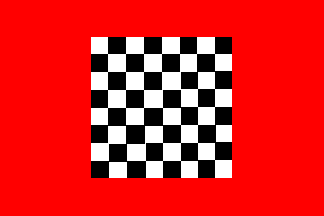
The oldest known flag of Morocco is shown in the Libro de
Conoscimiento de Todos los Reynos
[lcr50]. This flag is supposed to
have been used by the rulers in Morocco in XI-XIIIth
century. The flag is red with a 64-square chessboard placed in the
middle of the flag. The upper left square of the chessboard is white.
Red might refer to the Fatimids, white to the Umayyads and black to the
Abasids, who had established a protectorate over Kairuan and Fes.
Ivan Sache, 15 Jun 2003, based on
[lux01]
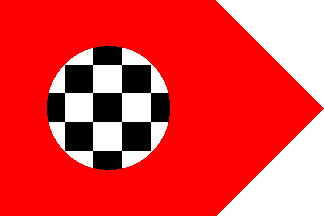
In [neu39a], captioned «Marokko
1367» a squarish red flag with a swallowtail at the top only. In the
center is a circle of blue/white checkerboard.
John Niggley, 25 Jan 1996
«Marokko 1367», the date being probably that of a portulano showing that flag. Neubecker’s statement leaves little doubt as to the reliability of medieval portulanos as a flag source:
Flags in the pattern of attributed arms were straightaway assigned even to exotic lands whose flags were certainly unknown, as e.g. Marocco.Santiago Dotor, 18 Jun 2003
The so-called Charles V’s Atlas
[vchXX] shows a similar flag, which
ended with a triangle and has a circular chessboard placed in the
middle.
Ivan Sache, 15 Jun 2003, based on
[lux01]
That is not the flag of the Kingdom of Morocco, it is
the flag of the city of Marrakech.
Jaume Ollé, 09 Oct 1998
I believe it is very difficult to ascertain the identity of
those flags, which are probably variant or erroneous copies of
a single archetypal flag.
Ivan Sache, 15 Jun 2003
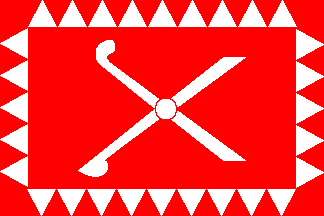
This flag can be found on several old flag charts.
Jarig Bakker, 21 Aug 1999
Morocco had around 1884 a red flag, with a border of red and white
triangles, in the center two white scimiatrs crossed.
Josh Fruhlinger, 11 May 1996
The book [noh71] shows as flag #250,
captioned «Emperor of Morocco», with slightly more triangles and in black
details in the "scissors": an eye in each handle, and a circle and a pin
in the circle in the centre. [bel63], as
shown in [sie63], has nearly double the
triangles, and open eyes.
Peter Hans van den Muijzenberg, 21 Jan 1999
It might be note here that the Zulfikar flags were
commonly misinterpreted by mideval European painters
(and flag authorities) as flags showing (tailor’s) scissors!
[or crossed scimiatrs].
Željko Heimer, 20 Aug 1999
On this chart [bel56],
the flag is labelled "Morocco" and
consists of a red field with a border made of red and
white triangles and with white open scissors centered.
Thus, the Moroccoan flag should then be a red flag with
the zul-faqar centered and a red/white border of
triangles, all these elements white.
Jorge Candeias, 21 Aug 1999

The Piemontese Chronicles report that, in 1781, a vessel flying
a red flag «with two white scissors» moored in the port of
Villafranca (now Villefranche-sur-Mer, in France).
The vessel came from «the Sultanate of Morocco».
Lux-Wurm [lux01] says that these
“scissors” were in fact two misinterpreted sabers.
But he himself fails to interpret these sabers as the famous
zulfikar.
Ivan Sache, 15 Jun 2003
The dhu-ul-fiqr or thul fuqar or zul-faqar or
zulfikar (or any of a number of transliterations from the
Arabic)
has been used as a symbol of Morocco because the ruling Alaouite dynasty
claims legitimacy by virtue of descent from the Prophet’s
son-in-law, Ali. Dhu-ul-fiqr was Ali’s sword, the
blade of which was split in half.
Joseph McMillan, 21 Aug 1999
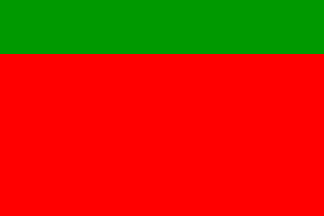
The book [noh71] shows as flag #251,
captioned «Moors», a red flag, upper 1/4th green.
Peter Hans van den Muijzenberg, 21 Jan 1999
The book [noh71] shows as flag #250,
captioned «Morocco War», a blue flag, near the hoist an arm holding a sword,
all white detailed black. Upper-arm horizontal, lower arm bare and upward,
even a bit back towards the hoist, sword (a falchion?) almost level towards
the hoist. (This is either a sinister hoist or a
sinister arm.)
Peter Hans van den Muijzenberg, 21 Jan 1999
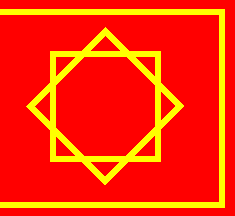
During the “pacification” campaigns in the early XXth
cent., French and Spanish
troops captured war flags from Moroccan tribes; these were based on the
Marinid emblem, a red field with two yellow interlaced
squares forming a star.
Ivan Sache, 15 Jun 2003, based on
[lux01]
On 16 April 1908 on Menaba, Lieutenant-Colonel Perron captured a 2:3
flag based on the Marinid pattern, with a yellow crescent placed in each
angle of the flag. On 6 September 1912, General Mangin captured in Sidi
Bu Othman a similar flag, with a small crescent and full moon iside the
Marinid emblem. Those two flags are kept in the Army Museum in Paris.
Ivan Sache, 15 Jun 2003, based on
[lux01]
The refered eight pointed blue star seems to be the symbol "Start of Rub el Hizb", found in Unicode under U+06DE (see http://www.unicode.org/). This is an islamic sign and is found in other emblem and flags. For instance:
Other sites: